Irises have been a favourite in the garden since Ancient Greeks associated this perennial with the Greek goddess Iris, messenger of the gods, who acted as the link between heaven and earth.
There are a number of irises that grow from bulbs planted in the fall. Most of these are early, ground-hugging plants, except for the Dutch iris, which grows up to two feet tall. Some of the dwarf irises such as the yellow Iris danfordiae and the Iris reticulata that comes in a variety of colours will often grow here but disappear after two or three winters. The Dutch iris will not overwinter here.
Most gardeners are familiar with the old-fashioned purple bearded iris. Bearded irises come in a variety of colours and colour combinations. Unfortunately, most of the newer cultivars of bearded iris are not hardy for us. Older varieties are hardier. I have a division from a yellow and bronze bearded iris which had been growing in a Winnipeg garden for many years and it is fully hardy.
The thing to remember about bearded iris is that they should not be planted too deeply. The fleshy rhizome that looks like a short thick stick has roots and leaves at one end - the roots should be planted in the soil with the top of the rhizome at ground level. The plant grows from the tip of the rhizome, moving forward every year, so that after a few years it has grown out of its area and has to be replanted.
A lesser-known iris, fully hardy for us, is the Siberian iris. This perennial has long, narrow leaves, graceful stems and large flowers. Initially they were available in shades of purple, but more recently breeders have developed other colours and variations from white to yellow to blue and red-violet, and even brown and orange shades. The flowers come with a variety of colour combinations and marking, and some are frilly. I have not tried the newest shades for hardiness, but intend to get some this fall. This iris is well-behaved, growing in a clump that slowly expands. After several years the centre of the clump may die out. The clump can be dug up and the growing outside rim divided and replanted.
All irises prefer at least six hours of sun in an average garden soil. There are some other irises not mentioned here, such as the yellow flag iris and the native blue flag iris, which prefer a moist or even wet environment. If you have not grown any irises, give some a try for spring to




